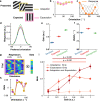Expectation violations enhance neuronal encoding of sensory information in mouse primary visual cortex
- PMID: 36864037
- PMCID: PMC9981605
- DOI: 10.1038/s41467-023-36608-8
Expectation violations enhance neuronal encoding of sensory information in mouse primary visual cortex
Abstract
The response of cortical neurons to sensory stimuli is shaped both by past events (adaptation) and the expectation of future events (prediction). Here we employed a visual stimulus paradigm with different levels of predictability to characterise how expectation influences orientation selectivity in the primary visual cortex (V1) of male mice. We recorded neuronal activity using two-photon calcium imaging (GCaMP6f) while animals viewed sequences of grating stimuli which either varied randomly in their orientations or rotated predictably with occasional transitions to an unexpected orientation. For single neurons and the population, there was significant enhancement in the gain of orientation-selective responses to unexpected gratings. This gain-enhancement for unexpected stimuli was prominent in both awake and anaesthetised mice. We implemented a computational model to demonstrate how trial-to-trial variability in neuronal responses were best characterised when adaptation and expectation effects were combined.
© 2023. The Author(s).
Conflict of interest statement
The authors declare no competing interests.
Figures






Similar articles
-
Pure tones modulate the representation of orientation and direction in the primary visual cortex.J Neurophysiol. 2019 Jun 1;121(6):2202-2214. doi: 10.1152/jn.00069.2019. Epub 2019 Apr 10. J Neurophysiol. 2019. PMID: 30969800
-
Mapping stimulus feature selectivity in macaque V1 by two-photon Ca2+ imaging: Encoding-model analysis of fluorescence responses to natural movies.Neuroimage. 2018 Oct 15;180(Pt A):312-323. doi: 10.1016/j.neuroimage.2018.01.009. Epub 2018 Jan 10. Neuroimage. 2018. PMID: 29331450
-
An Unexpected Dependence of Cortical Depth in Shaping Neural Responsiveness and Selectivity in Mouse Visual Cortex.eNeuro. 2020 Mar 23;7(2):ENEURO.0497-19.2020. doi: 10.1523/ENEURO.0497-19.2020. Print 2020 Mar/Apr. eNeuro. 2020. PMID: 32051142 Free PMC article.
-
Audiovisual Modulation in Mouse Primary Visual Cortex Depends on Cross-Modal Stimulus Configuration and Congruency.J Neurosci. 2017 Sep 6;37(36):8783-8796. doi: 10.1523/JNEUROSCI.0468-17.2017. Epub 2017 Aug 8. J Neurosci. 2017. PMID: 28821672 Free PMC article.
-
Bottom-up and top-down dynamics in visual cortex.Prog Brain Res. 2005;149:65-81. doi: 10.1016/S0079-6123(05)49006-8. Prog Brain Res. 2005. PMID: 16226577 Review.
Cited by
-
Expectation violations produce error signals in mouse V1.Cereb Cortex. 2023 Jun 20;33(13):8803-8820. doi: 10.1093/cercor/bhad163. Cereb Cortex. 2023. PMID: 37183176 Free PMC article.
-
Prediction of future input explains lateral connectivity in primary visual cortex.Curr Biol. 2025 Feb 3;35(3):530-541.e5. doi: 10.1016/j.cub.2024.11.073. Epub 2025 Jan 10. Curr Biol. 2025. PMID: 39798566 Free PMC article.
-
Context flexibly modulates cue representations in visual cortex.Nat Commun. 2025 Jul 1;16(1):5516. doi: 10.1038/s41467-025-61314-y. Nat Commun. 2025. PMID: 40593715 Free PMC article.
-
Cooperative thalamocortical circuit mechanism for sensory prediction errors.Nature. 2024 Sep;633(8029):398-406. doi: 10.1038/s41586-024-07851-w. Epub 2024 Aug 28. Nature. 2024. PMID: 39198646 Free PMC article.
-
Effects of satisfying and violating expectations on serial dependence.J Vis. 2023 Feb 1;23(2):6. doi: 10.1167/jov.23.2.6. J Vis. 2023. PMID: 36753122 Free PMC article.
References
Publication types
MeSH terms
Substances
LinkOut - more resources
Full Text Sources
Miscellaneous

